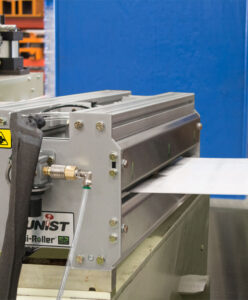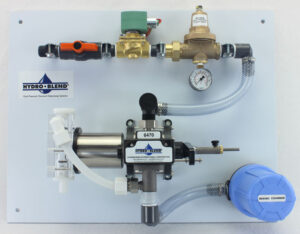Fluid Equipment
Much of the Impact Fluids Lifecycle Analysis involves evaluating how fluids are mixed, applied, and reclaimed. Poor fluid handling equipment or methods can contribute to excess waste, increased costs, and hazardous work environments. If there’s fluid on the machine, the floor, or in the part bins, that’s a sign fluid application can be optimized. While improving existing equipment management can help, true efficiency gains often come from investing in better mixing, application, and reclamation systems.
Fluid Application
Fluid application methods vary widely, from simple drip cans and oily rags to precision-engineered systems that minimize waste and improve efficiency. If stamping fluid drips down the press, mists into the air, or pools on the floor, it’s not helping carry the frictional load—it’s just wasted money and a potential safety hazard.
Roller Coating Systems
Roller coaters provide a controlled, uniform layer of lubricant, reducing excess application while ensuring even coverage. The Unist Uni-Roller with SmartFlow applies fluid precisely on the top and bottom of the stock only, reducing usage by up to 90% compared to traditional airless spray systems.
For added precision and efficiency, the SmartFlow® programmable fluid controller integrates seamlessly with the Uni-Roller system, allowing real-time monitoring and adjustments to fluid application—ensuring the right amount of lubricant is applied every time, reducing waste and improving part quality.
Spray Systems
Spray systems are a common way to apply cutting fluids, but overuse leads to waste and inefficiencies. Flooding, misting, and micro-lubrication all serve different purposes, but precision spray systems like the Unist LV Spray System offer a more controlled alternative, reducing fluid consumption by 25-50% compared to standard airless spray methods.
Fluid Mixing
Properly mixing metalworking fluids is critical to optimizing performance and reducing waste. Metalworking fluids—whether straight oils, synthetics, or semi-synthetics—must be mixed precisely to manufacturer specifications. Inconsistent mixing leads to excessive fluid use, poor tool life, and production inefficiencies.
At Impact Fluids, we ask key questions: Is your mixing consistent? Is it manual or automated? Could mixing be centralized? Our proportioning pumps and centralized mixing systems eliminate guesswork, ensuring accuracy and efficiency at every stage.
💧Proportioning Pumps: Achieve 99% mixture accuracy for optimal fluid performance.
💧Centralized Mixing Systems: Deliver premixed fluid to each machine for consistent, efficient operations.
Reclamation Systems
When proper mixing and application aren’t enough to reduce waste, reclamation systems provide a solution. These systems filter contaminants from excess fluid, allowing it to be reintroduced with fresh lubricant. By consistently using clean oil and coolant, manufacturers can reduce total fluid consumption by up to 50%, lower disposal costs, and extend tool life.






